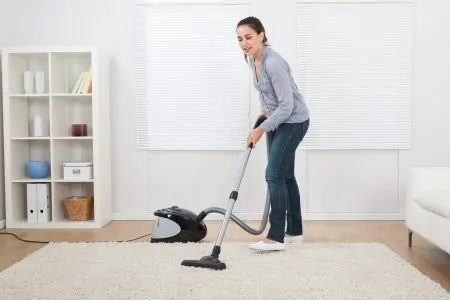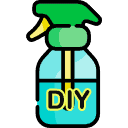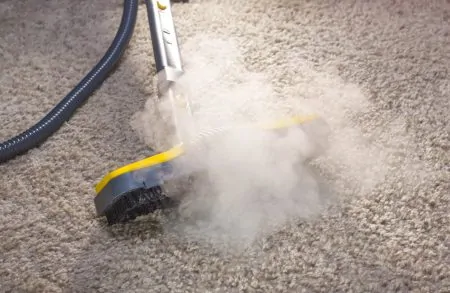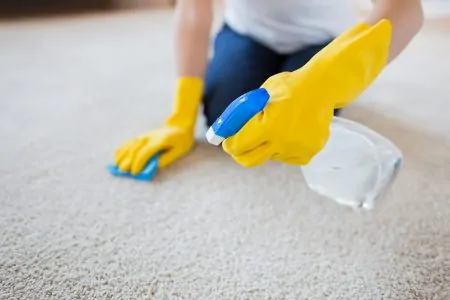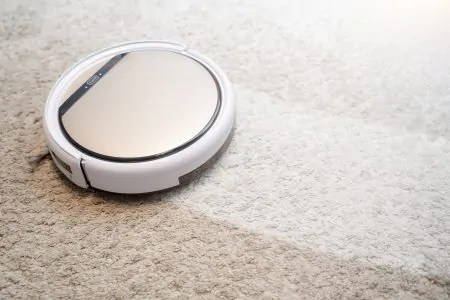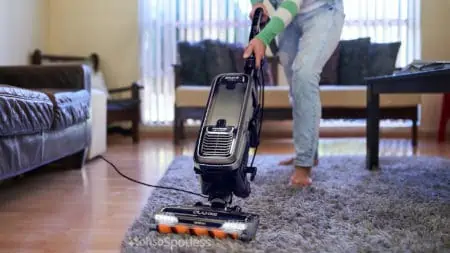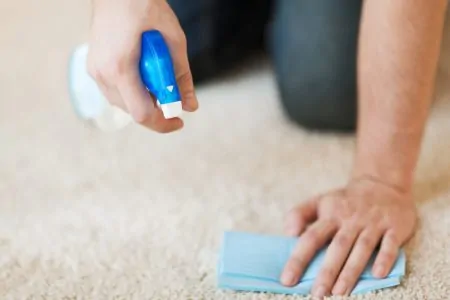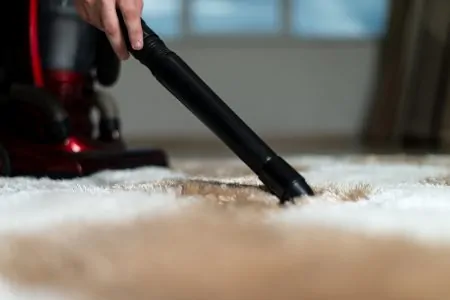An area rug can add a nice touch of color, pattern, and texture to any room. But it can quickly collect dust, dirt, and debris from food items, pets, and foot traffic.
Owning such a home item comes with responsibility. Every area rug owner should know to clean an area rug.
Sadly, these rugs don’t always come with in-depth instructions. That’s where we come in. We’ve put together a fantastic guide to get your area rug looking as beautiful as it did the day you bought it.
Key Takeaways
- Vacuum your area rug weekly, paying attention to both sides, to minimize dust and debris.
- Deep clean your rug when it’s visibly dirty, using a suitable rug shampoo and proper drying techniques.
- Remove pet hair with a small, stiff brush, avoiding metal-bristled brushes that may damage rug fibers.
- Consider using a carpet cleaner for easier deep cleaning, but be aware that they can be expensive.
Vacuuming your rug can help keep dust and dirt at bay, but you’ll need to go deeper for stains.
How often you should clean your area rug depends on where it is. Rugs in high-traffic areas will need more cleaning. A good rule of thumb is to leave the deep cleaning until the rug is visibly dirty.
Vacuuming an Area Rug
You should aim to vacuum your area rug regularly, at least once per week, to keep debris and dust to a minimum. Vacuum more often if you have children and pets.
- Time: 10-30 minutes
- Difficulty: Easy
1. Start at the Top
If applicable, set your vacuum to the carpet setting. Take extra care if your rug has extra-long fibers. Vacuum beater bars or rollers can tangle them or rip them off the carpet (1).
Push the vacuum back and forth across the rug. If you have a large area to cover, try to work in sections so that you’re sure you cover every part.
To deodorize your rug, you can use baking soda about every three months or so. Sprinkle a generous amount across all areas of the rug and allow it to sit for a few minutes.
The baking soda will quickly absorb any odor that might be lingering. Then, vacuum the entire rug thoroughly to get rid of the powder (2).
Oriental, antique, Persian, and homemade rugs are more sensitive, and you should be careful when vacuuming. Use a low suction without any attachments, or cover the rug with a nylon screen. This will keep the fibers protected while still being able to remove fine dust and dirt.
2. Flip Your Rug
Many people don’t give much thought to the underside of an area rug. But this is a mistake. A significant amount of dust and dirt can quickly gather underneath your carpet.
After flipping it over, vacuum the underside using long strokes back and forth. Flip the rug back once you’re done.
Doing this will help to keep allergens at bay. It can be essential in a household where one or more family members deal with allergies. Dust mites like to hide within thick fibers, and even after they die, their skeletons can stay behind and cause trouble if inhaled (3).
3. Take Small Rugs Outside
If you have smaller rugs, you can take them outside and give them a good shake. This will help dislodge debris, dirt, and dust that hold onto the fibers. If possible, hang the rug on a wall or line, and use a broom or carpet beater to get the last dirt out.
Take Note
4. Remove Hair
Having pets can be a joy, but it can also be a pain if they shed a lot. Hair will quickly stick to a rug, making it difficult to remove. Some vacuums aren’t able to remove embedded pet hair.
For this, you should use a small, stiff brush. Brush using repetitive strokes to force the hair out. Clean the brush in between to avoid spreading the hair more.
Rubber brushes, such as this from Carrand, can also come in handy since it’s easier to clean than bristles. It uses static electricity to attract hair and fur quickly.
Avoid Metal
Deep Cleaning an Area Rug
When your rug is really dirty, and a regular vacuuming session doesn’t help, it’s time for a deep clean.
- Time: 3 hours (plus drying time)
- Difficulty: Intermediate
1. Find a Suitable Rug Shampoo
There’s a wide range of choices available for carpet and rug shampoos — but you should choose wisely. You must use a product designed for the material in your rug. If you’re unsure about the material, check the label underneath the rug.
Check The Label
Do a small spot test in an inconspicuous area to ensure the shampoo is safe for the material. Apply about half an inch’s worth of shampoo and leave it for one to two hours. Then inspect the area once the time is up and look for any signs of discoloration.
If you notice discoloration, do not use that product. Most stores and manufacturers allow you to return the product. Purchase a different one and run another test.
2. Saturate the Rug
If possible, one of the best ways to clean a larger area rug is to take it outside. Use a garden hose to saturate the carpet before applying the shampoo. If you don’t have a hose, you can dump multiple buckets onto the rug until it’s saturated.
Not everyone will be able to take their rug outside. In this case, you can use your bathroom. Place the rug in the middle of the bathroom and use the showerhead to saturate it. If the carpet is large, you can roll it and wash it in sections.
If these aren’t options, you can also take your rug to a car wash and quickly get the cleaning done.
3. Apply the Shampoo
Follow the directions and apply the shampoo as instructed. Use a brush to scrub the entire rug thoroughly — keep rubbing until it’s covered in bubbles or foam. Pay close attention to stained or extra dirty areas.
4. Rinse the Rug
After lathering the rug thoroughly, use the hose or shower head to rinse it clean. Keep rinsing until the fibers are free of foam or bubbles.
Use a squeegee to scrape off excess water. This will help the rug to dry quickly and help to get rid of leftover shampoo.
Caution
5. Dry the Rug
To dry the rug effectively, keep it in a well-ventilated room or outdoors. Work a standing fan or ceiling fan to help the process.
Use clean towels to soak up excess water. Place them on the rug and walk or jump on them to draw water out.
Depending on the thickness, it can take up to two days for the rug to dry thoroughly. Once the top is dried, flip the carpet and allow the underside to dry as well.
If you have a place to hang the rug, the sun and fresh air can dry it effectively. This will also reduce the chances of any odor developing.
How to Use a Carpet Cleaner
Cleaning an area rug isn’t a five-minute job; it can take a while, so make sure you free some time. However, you can make the job a little easier by using a carpet cleaner.
These come in various sizes, and most resemble and work similarly to vacuums. One machine favored by many homeowners is the Hoover PowerDash.
You start by filling the tank with warm or cold water (see the instructions). Add a cleaner, such as a carpet shampoo — make sure it’s safe for the machine you’re using. Most brands like Bissell, Hoover, and the Rug Doctor have specialized products available for the device.
Some carpet cleaners will have multiple settings to suit your task, so choose the appropriate setting.
Plug the device into an outlet and turn it on. Place the machine on the rug and push the handle trigger. Move the carpet cleaner back and forth while pushing the trigger to apply water and solution.
When the area is wet, make a dry pass by letting go of the trigger. Glide the floorhead back and forth until there’s no more water left on the rug (4).
A carpet cleaner is a quick and easy way to deep clean your area rug. However, it’s not the cheapest option. Most machines start at around $100 and can reach close to $500, depending on settings and attachments.
FAQs
Maintaining an Area Rug
Keeping your area rug clean is essential to avoid issues such as allergies caused by dust and dust mites. You can easily prevent these by vacuuming at least once a week on both sides of the rug.
Avoid damaging your rug and only deep clean it when necessary. Always choose a shampoo that’s safe for the material. Dry the carpet thoroughly by utilizing fans, or take it outside and let the sun work its magic.
